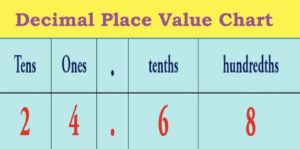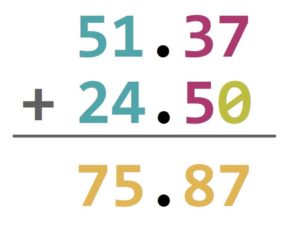Decimal fractions, often referred to simply as decimals, are numbers with a decimal point.
The digits to the LEFT of the decimal point refer to the whole number.
The digits to the RIGHT of the decimal point refer to the fraction, or part of the whole number.

The number 24.68 (read “twenty four point six eight) means that there are two tens and four ones making the 24, and 6 tenths and 8 hundredths (or 68 hundredths of a whole number).
When calculating using decimal fractions, it is crucial to keep the decimal points in a straight vertical line. For example:

Decimal fractions are often introduced during First Level as part of learning about the context of Money. As pupils move into second level, their learning of decimal fractions in a range of other contexts is explored.
CURRICULUM LINK:
I can use money to pay
for items and can work
out how much change
I should receive.
MNU 1-09a
I have extended the range
of whole numbers I can
work with and having
explored how decimal
fractions are constructed,
can explain the link
between a digit, its
place and its value.
MNU 2-02a
![]()
![]()
